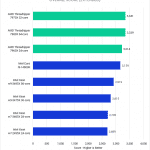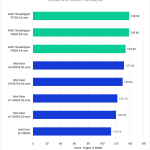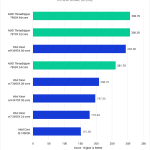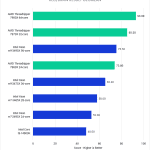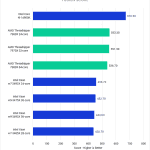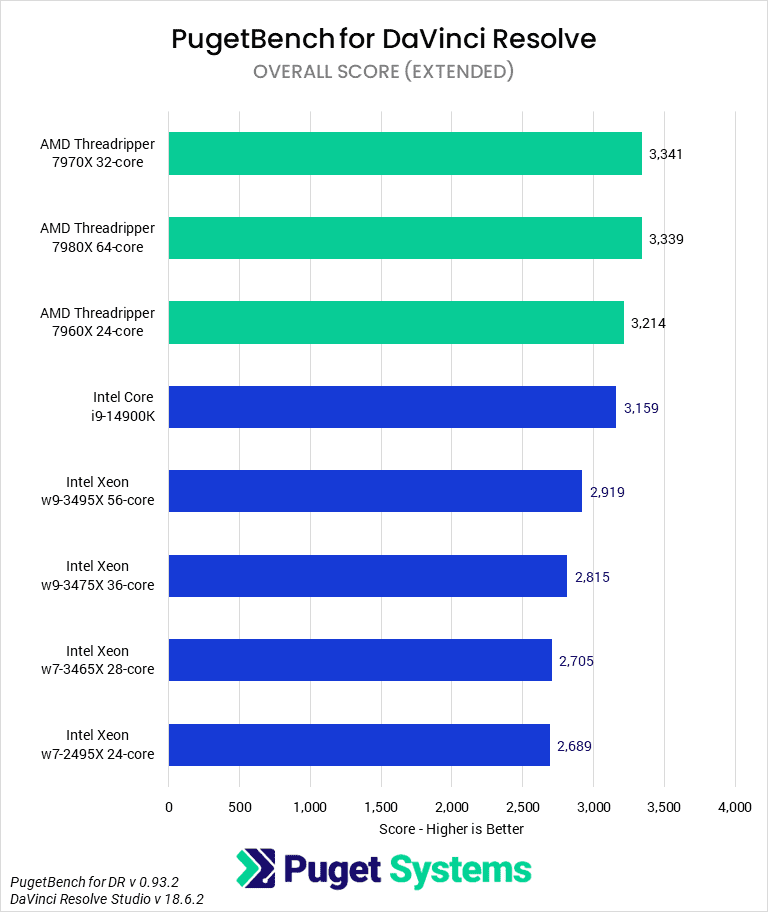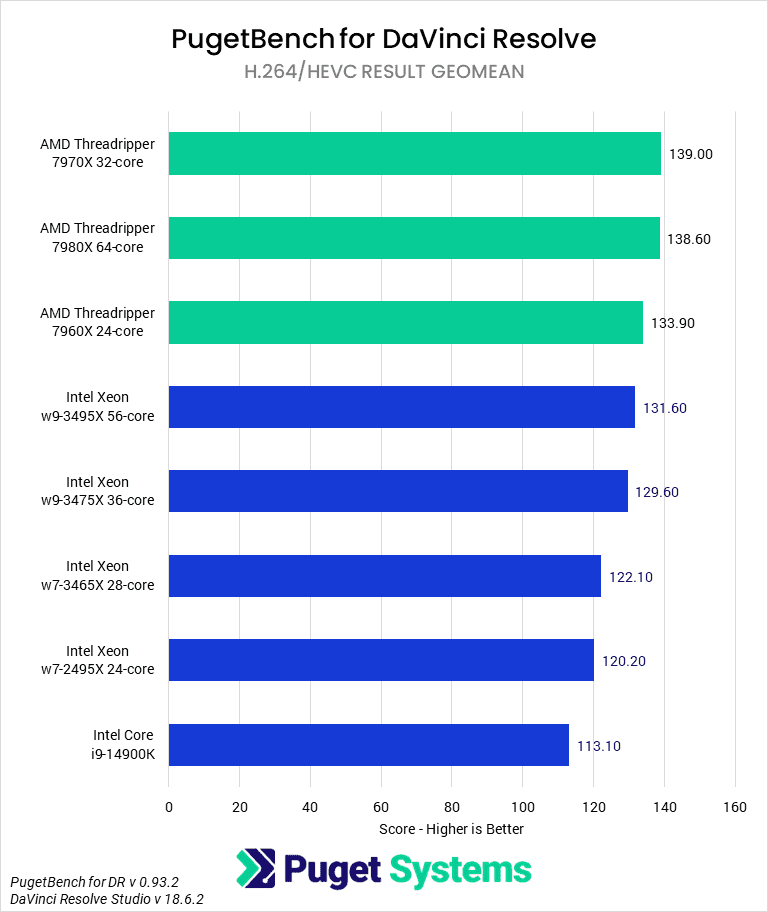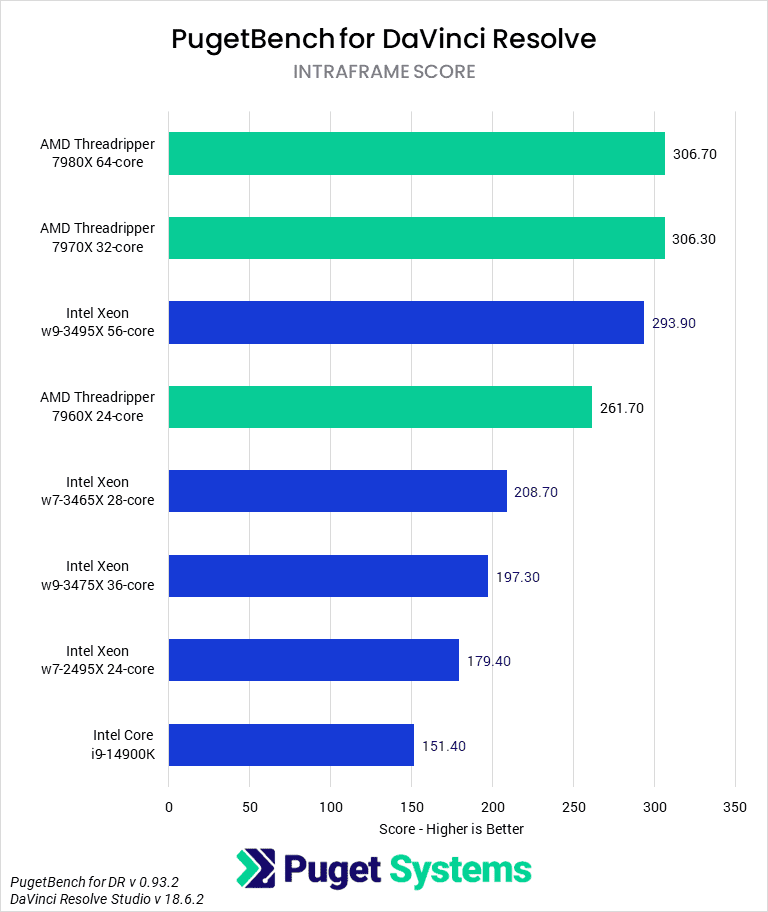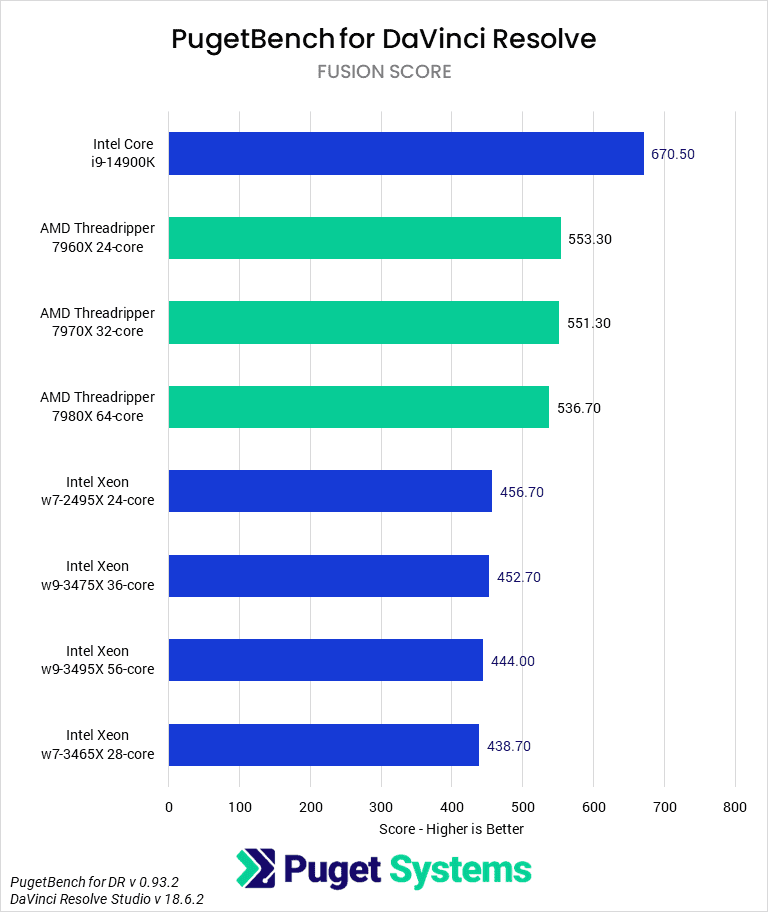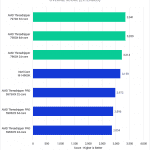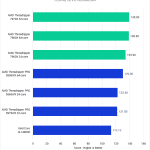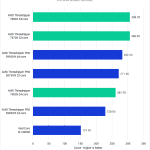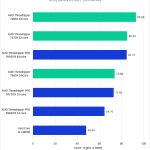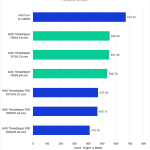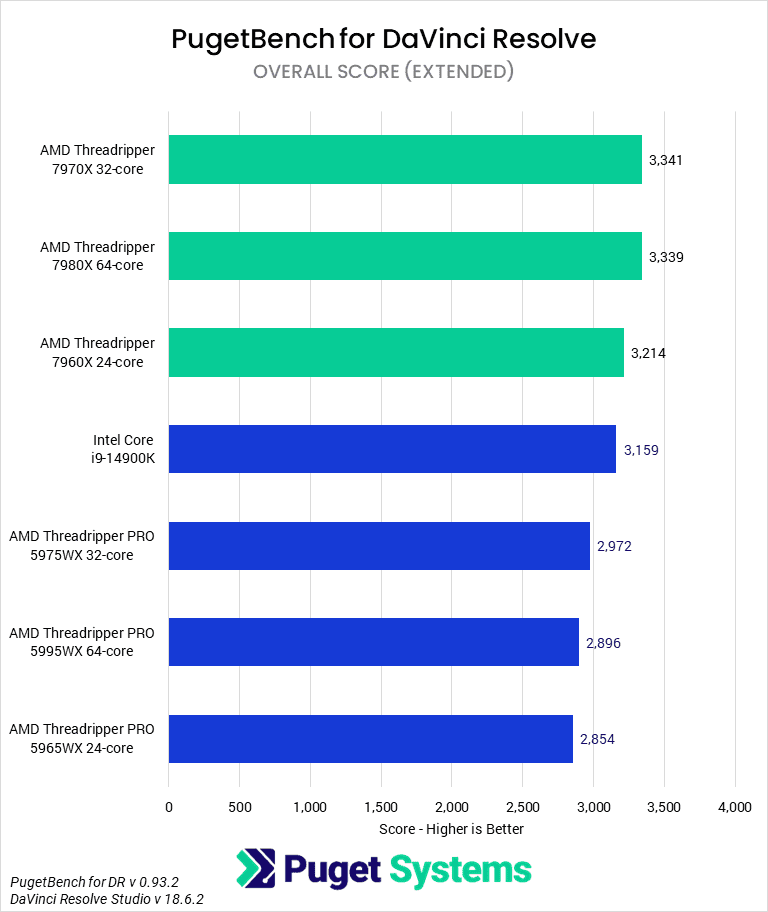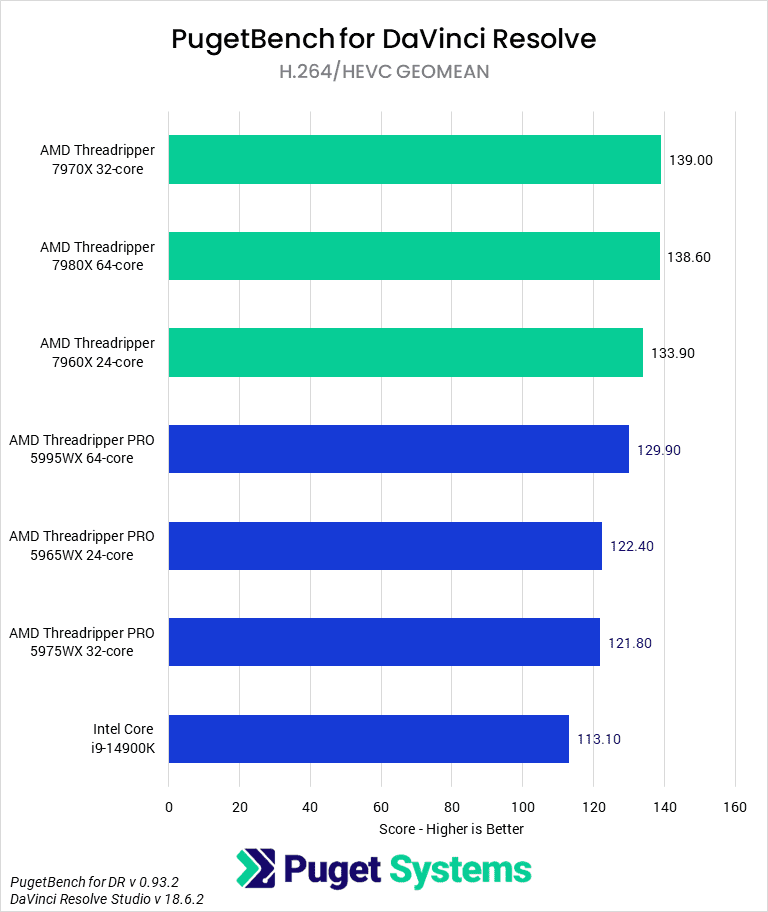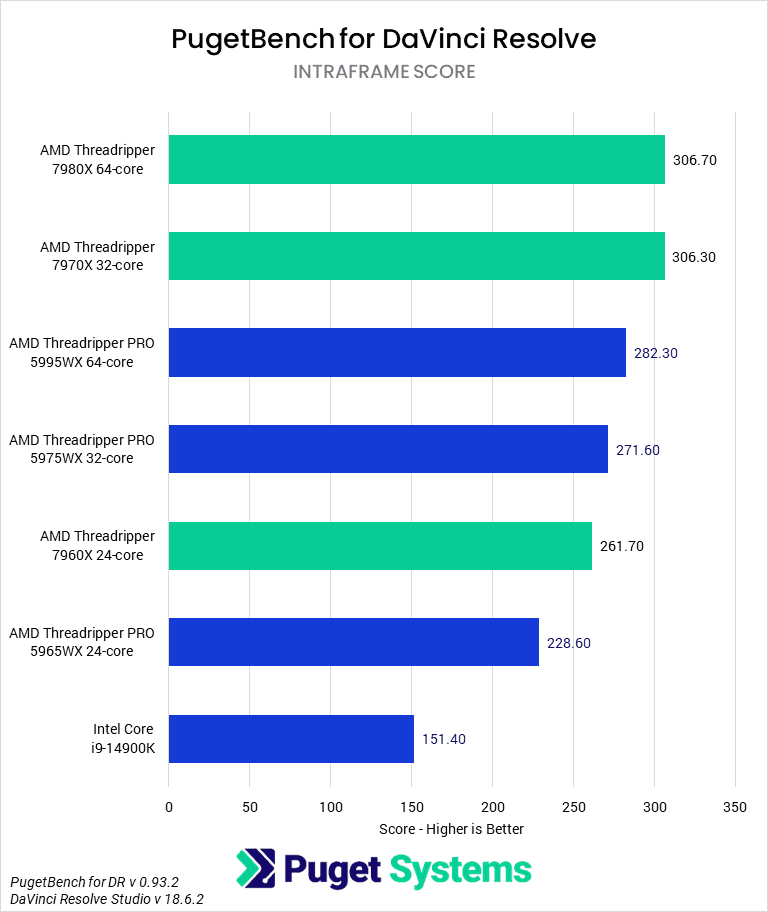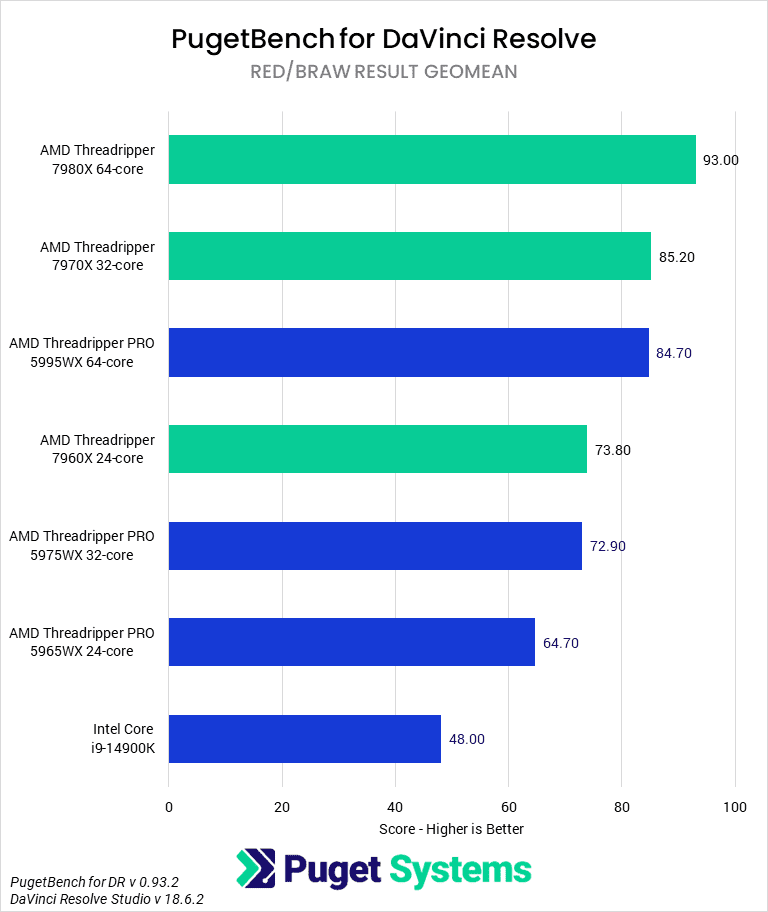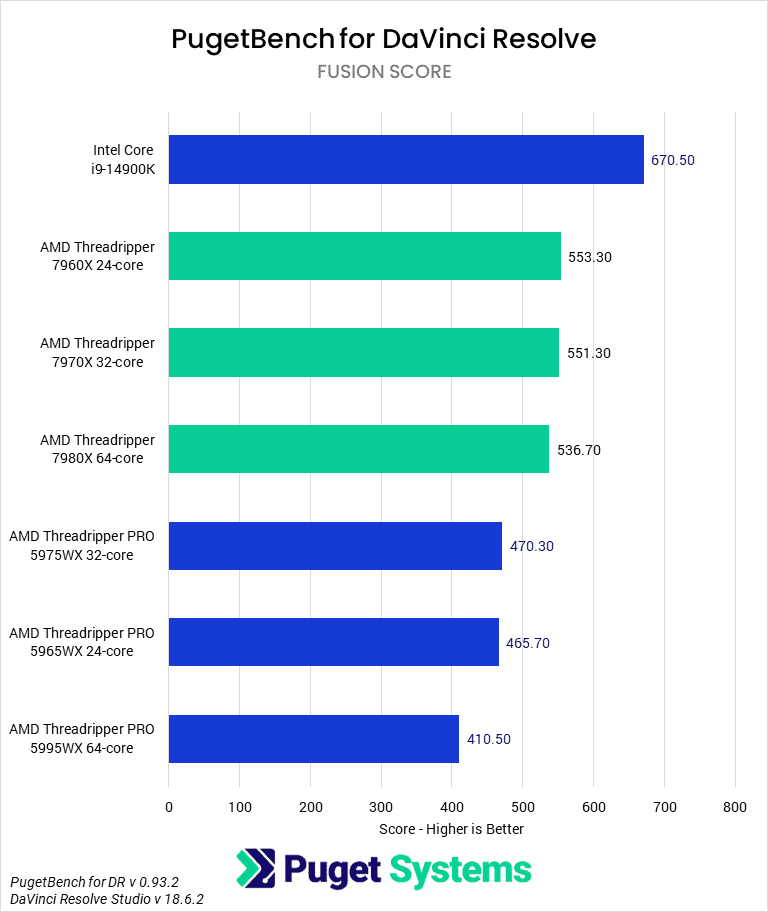Table of Contents
TL;DR: AMD Threadripper 7000 Performance in DaVinci Resolve
Overall, we found that the new AMD Threadripper 7000 processors in DaVinci Resolve Studio are around 15% faster than the previous generation Threadripper PRO 5000WX. The gain is larger in specific workflows like RAW and Fusion where they are closer to 20% faster, and smaller in others like LongGOP where the difference is closer to 10%.
This is a decent performance gain from a single generation – especially since the new Threadripper 7000 CPUs are less expensive than the previous generation Threadripper PRO 5000WX. It also makes AMD solidly faster than any Intel Xeon W CPU currently on the market – to the tune of about 20% overall, or a much larger 40% for Intraframe and RAW codecs. Given that RAW codecs in particular tend to be one of the main reasons to invest in this class of CPU, that gives AMD a very healthy lead over Intel at this level.
Introduction
With the new Threadripper 7000 and Threadripper PRO 7000WX CPUs, AMD is once again splitting their high core-count CPUs into two separate product families: the High-End Desktop (HEDT) AMD Ryzen Threadripper 7000 Series, and the even higher tier AMD Ryzen Threadripper PRO 7000 WX-Series processors. Both are based on AMD’s Zen 4 architecture, which means they now support new technologies like PCI-e Gen 5.0 and DDR5 memory, but we also expect an increase in both per-core and multi-core performance.
The big difference between the Threadripper and Threadripper PRO families is that Threadripper PRO offers more memory channels, additional PCIe lanes, and a 96-core processor that isn’t available from the Threadripper line. While the increased memory channels shouldn’t affect DaVinci Resolve significantly, the extra PCIe lanes could come into play for high-end workflows. Threadripper still offers 48 Gen5 lanes through the CPU, however, which is more than enough for two GPUs and an add-on card like a Blackmagic Decklink (assuming you can find a motherboard with the appropriate PCIe slot layout). It will only be the increasingly rare system with three or four GPUs that will truly require Threadripper PRO.
We don’t expect Threadripper PRO 7000WX to provide much of a performance benefit on its own, although we will have to wait until WRX90 motherboards are available to see for sure. Threadripper PRO 7000WX may have officially launched alongside Threadripper 7000, but that doesn’t mean that it is fully available in the market – even in the small quantities we need for a performance evaluation.
Today, we want to focus on the performance of the Threadripper 7000 Series (non-PRO) compared to the previous generation Threadripper PRO 5000WX and the Intel Xeon W-2400/3400 line. In our last Intel Xeon W-3400 review, we found that the Xeon CPUs were slightly faster than Threadripper PRO in most situations, but the margin was small enough that we expect Threadripper 7000 to give AMD the lead again. In addition to Threadripper PRO and Xeon, we will also include the Intel Core 14900K to provide some context for how AMD Threadripper compares to a more typical CPU choice for this type of workload. This is especially important for video editing, as the 14900K includes Intel Quick Sync, which can provide a performance boost for H.264 and HEVC media compared to using your GPU for processing that type of codec.
Because there are so many CPUs to examine, we will break our analysis down into Intel vs AMD (AMD Threadripper 7000 vs Intel Xeon W-3400) and performance versus the previous generation (AMD Threadripper 7000 vs AMD Threadripper PRO 5000WX)
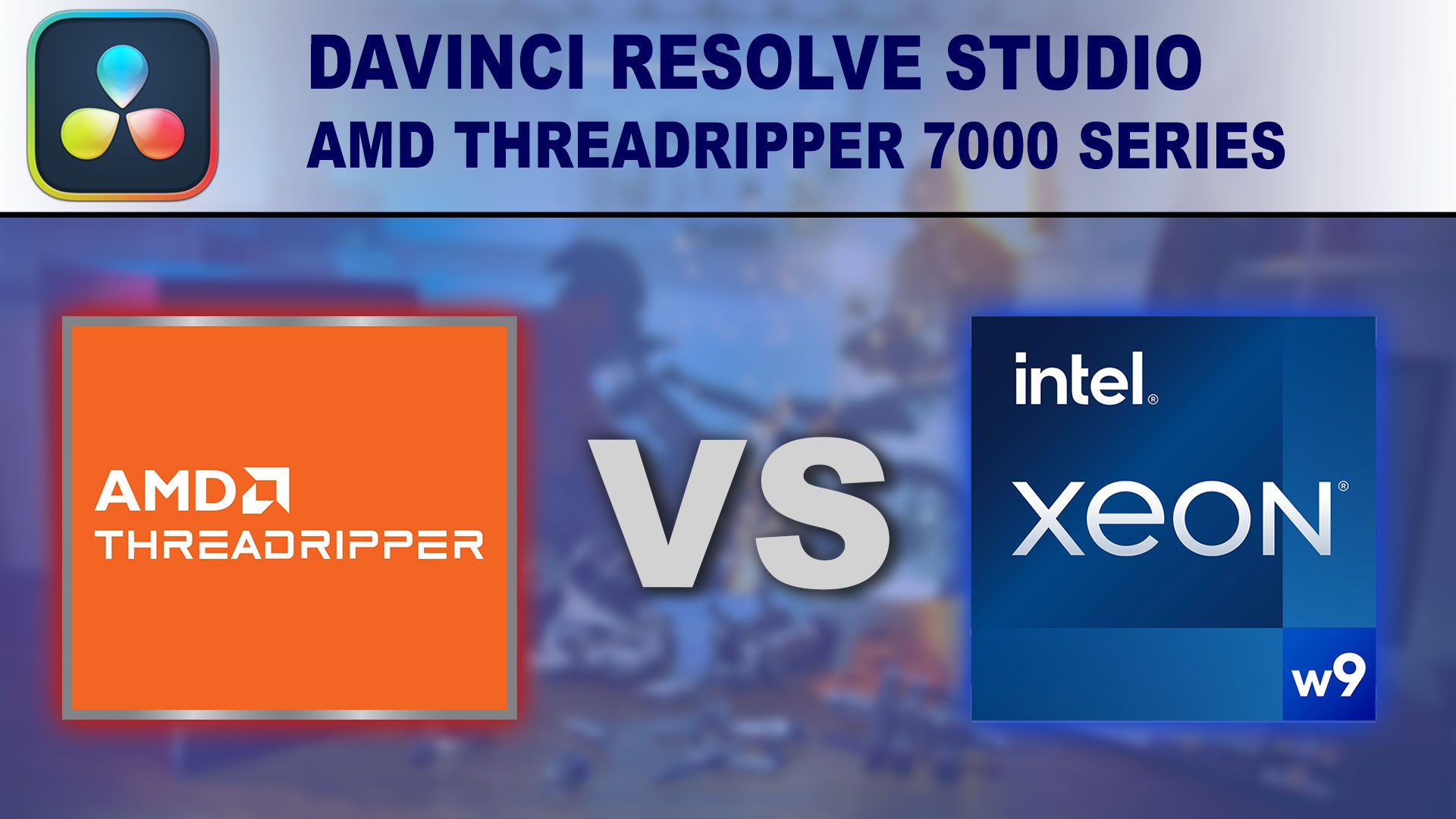
To learn more about how the new AMD Ryzen Threadripper 7000 Series processors perform in other workflows, we have compiled an overview in our AMD Ryzen Threadripper 7000 Content Creation Review article. That post also includes more detailed information on the CPU specifications and test results for various applications: Photoshop, Lightroom Classic, Premiere Pro, After Effects, Unreal Engine, Cinema 4D, Blender, and V-Ray.
In addition, although all the new AMD CPUs have a TDP of 350 W, TDP is rarely the whole story. To see how much power these chips use to complete tasks, check out our Power Analysis: AMD Ryzen Threadripper 7000 article.
Raw Benchmark Data
We design our benchmarks to cover a large swathe of workflows and tasks to provide a balanced look at the application and its hardware interactions. However, many users have more specialized workflows. Recognizing this, we like to provide individual results for benchmarks as well. If there is a specific area that comprises most of your work, examining those results will give a more accurate understanding of the performance disparities between components.
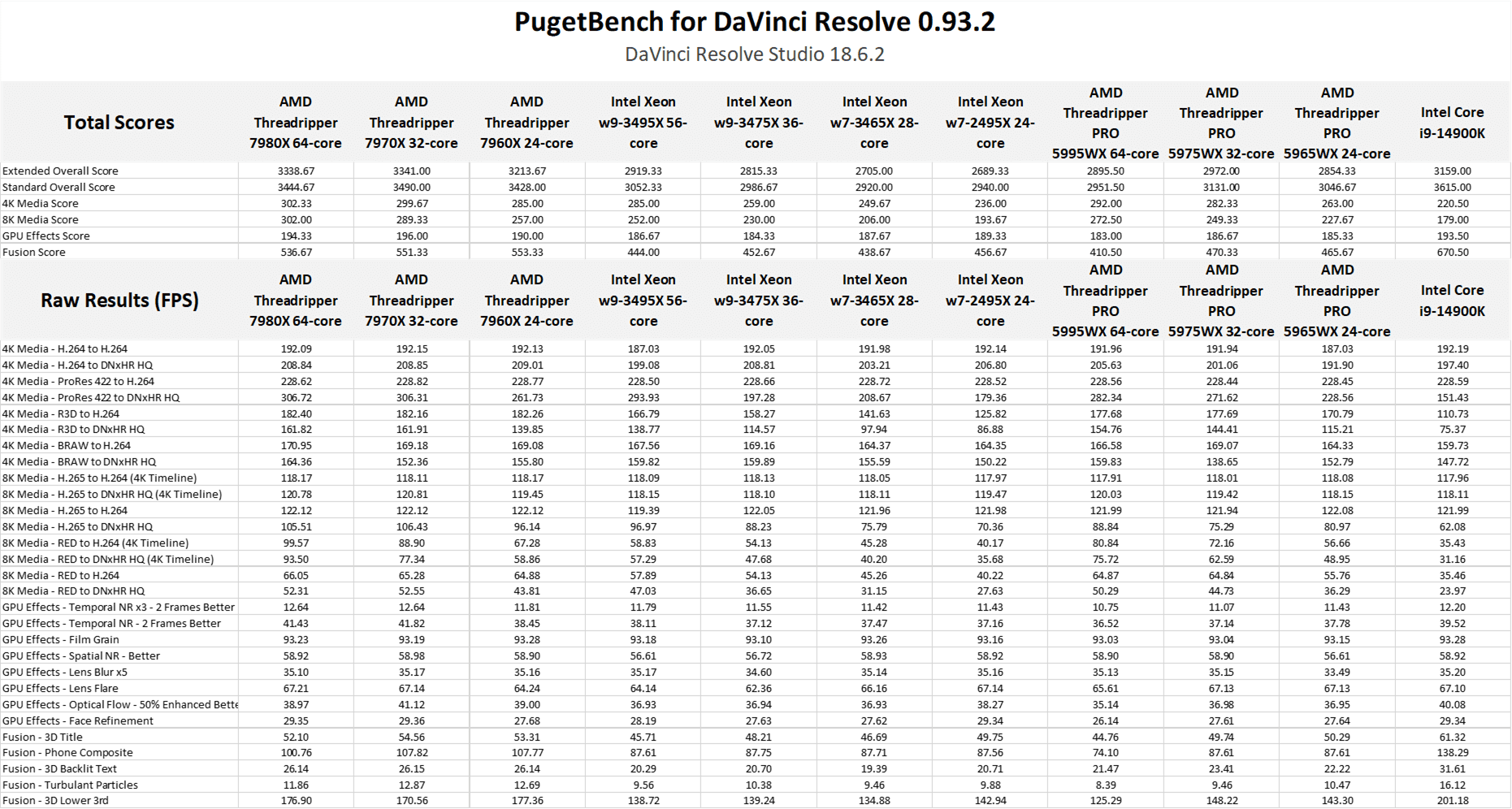
AMD Threadripper 7000 vs Intel Xeon W-3400 for DaVinci Resolve
Video Editing applications like DaVinci Resolve are among the more complex workflows we look at for CPU performance, as the best CPU depends on the type of media you are working with. LongGOP codecs like H.264 and HEVC (chart #2) are among the most commonly used and are a bit unique in that the hardware decoding and encoding capabilities of your system are often more important than the raw power of your CPU. Something as powerful as Threadripper can brute force its way through some things, but for specific flavors like HEVC 4:2:2 10-bit, there is no replacement for technology like Intel Quick Sync (found on the Intel Core family) that can be used for hardware decoding.
On the other hand, Intraframe codecs (chart #3) like ProRes and DNxHR are purely CPU-based. They are also among the easiest to work with, however, so a CPU that gives a lower benchmark score is often still well beyond the “good enough” level for most users. Lastly, RAW codecs (chart #4) like RED, ARRIRAW, and X-OCN are a mixed bag in how they use your system, but often benefit from having both a powerful CPU and a powerful GPU.
DaVinci Resolve is also unique in that it also includes Fusion (chart #5), which is used for motion graphics and VFX. Unlike the rest of Resolve, Fusion is primarily single-threaded, which typically makes an Intel Core or AMD Ryzen CPU better in terms of raw performance than Threadripper or Xeon.
With that explained, we can take a look at how the new AMD Threadripper 7000 series compares to the Intel Xeon W-2400/3400 line. Right away, you can tell that AMD comes out very favorably, with even the 7960X scoring above the fastest Intel Xeon W processor. Interestingly, the performance range between CPUs of the same family is fairly small, but that can change quite a bit if we dive into the results for specific codecs – most notably RAW.
Starting with the AMD Threadripper 7960X 24-core, the closest Intel Xeon CPU in price we tested was the Xeon w7-2495X 24-core, although the 2495X is actually closer in price to the 7970X 32-core. Still, it is a core-to-core comparison, and even with the Intel CPU being more expensive, the 7960X comes out on top by about 20% overall. However, that is just the overall average, and for specific tests like Intraframe, RAW and Fusion, the 7960X is closer to 35-40% faster.
Moving up a step to the Threadripper 7970X 32-core, the Xeon w7-2495X 24-core is again the closest price comparison from Intel. Here, AMD extends their lead a bit to 25% overall, or 60-70% for Intraframe and RAW codecs.
At the top of the stack, the Threadripper 7980X 64-core is a bit hard to compare because its price falls right in between the Xeon w9-3475X 36-core and the w9-3495X 56-core. Compared to the 3475X, the 7980X is about 20% faster overall, or 4-50% faster for Intraframe and RAW codecs. The more expensive 3495X closes the gap significantly, although even here the 7980X is 15% faster overall – mostly from a 20% performance lead in RAW and Fusion.
Overall, this gives the AMD Threadripper 7000 processors about a 20% performance lead on average, with the majority of that coming from a 40% lead for IntraFrame and RAW codecs. Since RAW in particular tends to be the main reason to invest in this class of CPU, that gives AMD a very healthy lead over Intel Xeon W.
AMD Threadripper 7000 vs AMD Threadripper PRO 5000WX for DaVinci Resolve
Comparing the new AMD Threadripper 7000 CPUs to the previous generation can be challenging since we are looking at two different classes of processors. The pricing between Threadripper 7000 and Threadripper PRO 5000WX is very different, as are the overall platform capabilities. However, the fact that Threadripper 7000 has fewer memory channels and PCIe lanes than Threadripper PRO 5000WX shouldn’t be much of a factor for most DaVinci Resolve users, so in most cases, the new Threadripper CPUs are simply faster – and cheaper – than the previous generation.
In terms of pure performance, we are looking at a decent 12-15% gain over the previous generation in most cases. There are a few isolated instances of a larger improvement (such as a 20-30% gain in Fusion), but it is otherwise pretty consistent across the board.
While the gen-to-gen performance gain isn’t quite as good as other applications like After Effects or CPU Rendering, it is better than others like Premiere Pro. Either way, it is still enough to put AMD firmly ahead of Intel for this CPU class.
How Well Do the AMD Threadripper 7000 CPUs Perform in DaVinci Resolve?
DaVinci Resolve Studio is an interesting application to look at for CPU performance because it includes a variety of workloads that utilize the hardware in your system very differently. For example, Fusion is lightly threaded, while Intraframe and RAW codecs scale decently with more CPU cores. But also, RAW codecs often use the CPU and GPU in tandem, meaning you have to balance the two.
Overall, we found that the new AMD Threadripper 7000 processors in DaVinci Resolve Studio are around 15% faster than the previous generation Threadripper PRO 5000WX. The gain is larger in specific workflows like RAW and Fusion where they are closer to 20% faster, and smaller in others like LongGOP where the difference is closer to 10%.
This is a decent performance gain from a single generation – especially since the new Threadripper 7000 CPUs are less expensive than the previous generation Threadripper PRO 5000WX. It also makes AMD solidly faster than any Intel Xeon W CPU currently on the market – to the tune of about 20% overall, or a much larger 40% for Intraframe and RAW codecs. Given that RAW codecs in particular tend to be one of the main reasons to invest in this class of CPU, that gives AMD a very healthy lead over Intel at this level.
It is worth noting that even though Threadripper 7000 does very well in DaVinci Resolve, it doesn’t mean that it is the best choice for every workflow. These processors will likely be our go-to recommendation for those working with RAW codecs in particular, but if you primarily use H.264 or HEVC codecs, an Intel Core 14th Gen processor is likely to be the better choice due to the hardware decoding capabilities of Intel Quick Sync.
But if you need raw compute power to churn through heavy codecs like RAW or the additional PCIe lanes for a dual GPU setup, Threadripper 7000 is the best we have tested to date. Threadripper PRO 7000WX may be able to push the performance even further and will allow for 3-4 GPU configurations, but we have to wait until WRX90 motherboards become available before we can test the PRO models to find out for sure.
Every application uniquely utilizes hardware, so our results here don’t necessarily translate to any other application. Our focus in this article centers specifically on Threadripper 7000’s performance in DaVinci Resolve Studio. However, we recommend checking out our AMD Ryzen Threadripper 7000 Content Creation Review article, which includes a broad overview of results for several different applications. If you use other software packages, it also has links to our in-depth testing articles for content creation: Photoshop, Lightroom Classic, After Effects, Premiere Pro, Unreal Engine, Cinema 4D, Blender, and V-Ray.
Finding the perfect workstation doesn’t have to be complicated. Explore our solutions page for a curated selection of recommended systems for a multitude of applications and workflows, or visit our custom configuration page if you already know the ideal hardware for your needs. If you need assistance with tailoring a system to a unique workflow or have any other questions, we encourage you to reach out to our dedicated technology consultants.


